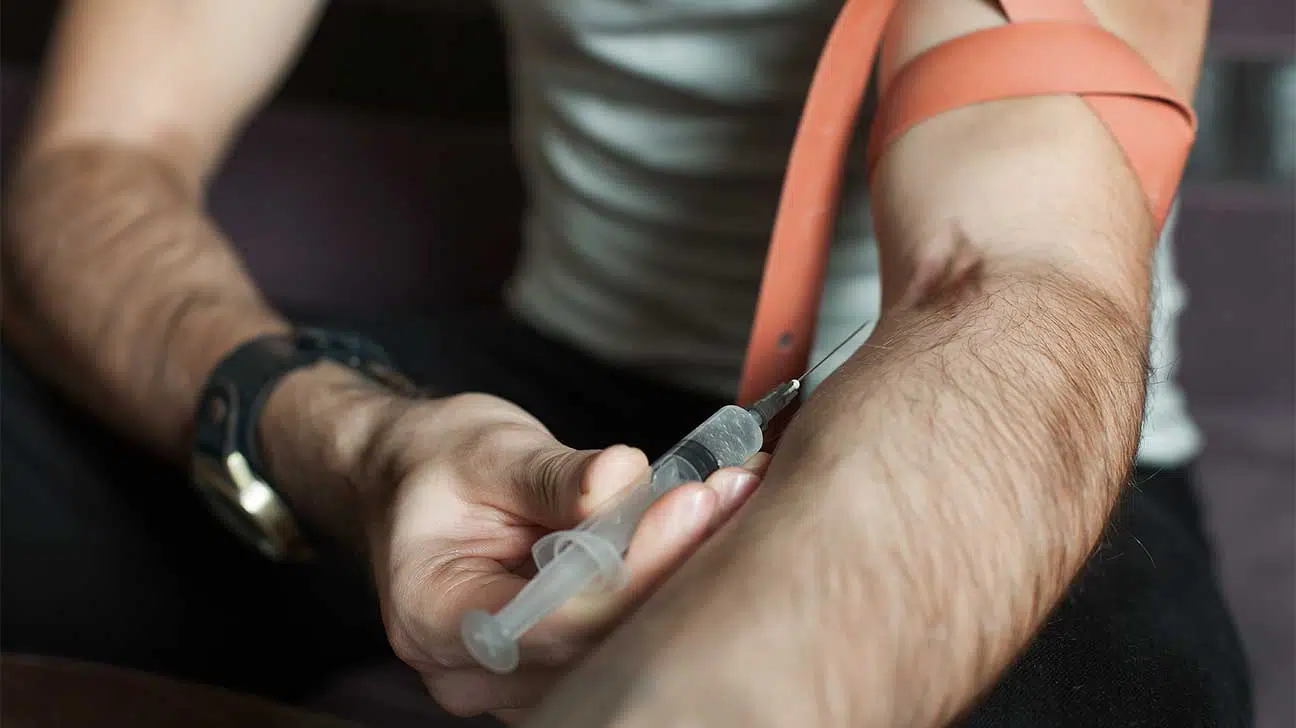Injecting Crack Cocaine: Dangers And Effects
Crack cocaine is known as a smokeable version of powered cocaine, but it can also be intravenously used. The typical effects of smoking crack may be intensified by the injection of crack cocaine. Intravenous crack use carries many dangers, including abscesses, heart failure, and an increased risk of infectious diseases.

Crack cocaine was developed as a way for people who engage in cocaine use to experience stronger effects for a cheaper price.
Most believe the only way to abuse crack cocaine is by smoking it. However, in places like New York and Connecticut, another crack cocaine route of administration is being used.
Injecting crack cocaine is an alternative for demographics who have a harder time finding powdered cocaine. Some say the effects of crack are intensified through injection.
Injecting cocaine poses many risks, including physical, mental, and public health concerns. Below we’ll discuss the dangers and effects of this illicit drug.
Effects Of Injecting Crack Cocaine
Crack’s history started in the 80s when it was introduced as a new form of drug abuse. Crack cocaine is made by mixing hydrochloride with baking soda, resulting in a rock-like substance.
Though intended to be a smokable drug, crack cocaine started to be injected around the 90s. Mixing a weak acid with crack cocaine makes it one of many skin-popping drugs.
To inject crack, the substance is melted down into a liquid, placed in a syringe, and injected directly into a vein.
Intravenous use sends a substance into the bloodstream. It reaches the brain much quicker compared to snorting or smoking, making crack more addictive than coke.
This leads to injectors of crack cocaine experiencing a quicker and stronger high. The resulting crack high will last anywhere from 15 to 30 minutes.
Short-term effects of injecting crack cocaine are:
- increased heart rate, blood pressure, and body temperature
- contracted blood vessels
- intense euphoria
- dilated pupils
- hyperstimulation
- nausea
Crack works on the brain by disrupting the recycling of dopamine between synapses. This causes an overload of dopamine.
After continued use, the body and brain may only receive pleasure from the drug. This can indicate that someone is addicted to crack.
With addiction and long-form use, many dangers may arise. Read on to learn more.
Dangers Of Injecting Crack Cocaine
There are many potential dangers of intravenous drug use. Risks come from both the use of cocaine and the method of abuse.
Some dangers of injecting crack cocaine are:
- flooding the blood with weak acids
- high risk of blood-borne illnesses, such as hepatitis C and HIV
- damaged heart functions
- increased risk of overdose
- aggression
- sexual dysfunction
- erratic behavior
- paranoia
- hallucinations
- body marks and bleeding from injection sites
- undernourishment and weight loss
- chest pain
- coma
- confusion
- endocarditis, a condition where the lining of the heart is damaged
- the development of co-occurring disorders
- increased frequency of risky behavior
- impotence
- tooth decay from crack use
Because of cracks addictive nature and how quickly it wears off, it’s quite common that people will go on binges.
This can cause a series of days or weeks where someone will inject cocaine at a high rate. They may ignore other people, responsibilities, and health.
Let’s take a closer look at some of these dangers.
Increased Risk Of Overdose
Injecting cocaine heightens the risk of overdose because it makes it harder to determine cocaines purity.
By injecting crack, tolerance and addiction grow faster. This will lead to more intense cravings and injecting larger doses to achieve desired effects.
A crack overdose from injection can look like:
- intense audio and visual hallucinations
- delirium
- rapid or irregular heartbeat
It’s best to call 911 and let medical providers take care of an overdose.
Flooding Blood With Weak Acids
To make crack cocaine injectable, it has to be mixed with a weak acid.
Examples of weak acids are:
- lemon juice
- vitamin C (ascorbic acid)
- citric acid
- white vinegar
- alcohol melt
The continued use of lemon juice and crack has been associated with endophthalmitis and inflammation of the veins. These acids can also cause circulatory system problems.
Impact On Heart Functions
Cocaine causes much strain on the heart. Being a stimulant, cocaine speeds up the body’s functions, such as heart rate.
As the heart is having to work harder it can cause serious complications. Injecting crack puts tremendous stress on the cardiac index. This can lead to heart attacks, strokes, or death.
Find more information on cocaine’s effects on the heart.
High Risk Of Blood-Borne Diseases
Repeatedly using needles carries HIV risk and a prevalence of contracting blood-borne diseases. This is due to sharing or using unsanitized needles.
Intravenous use also breaks down vessels, making them more susceptible to disease.
People who inject crack are more likely to try other intravenous drugs, such as heroin. They may also combine heroin and cocaine, sometimes referred to as a “speedball.”
Dangers Of Withdrawing From Intravenous Crack Use
Cocaine is one of the most powerful and addictive drugs. This makes cracks withdrawal symptoms quite uncomfortable.
Injecting crack produces the strongest withdrawal symptoms since the drug is delivered faster and stronger to the brain than other methods of abuse.
Common crack withdrawal symptoms include:
- insomnia
- nightmares
- cravings
- anxiety
- depression
- fatigue
- slow movements and thoughts
- huge appetite
- inability to feel pleasure
- suicidal thoughts
The safest way to withdraw from crack is to enter a drug and alcohol detox program. These rehab centers can provide a safe environment while the body rids itself of toxins.
Cocaine Addiction Treatment In Massachusetts
If you or a loved one seek help for substance abuse, you can call a cocaine hotline where operators can assist you in finding an inpatient drug rehab program.
At Spring Hill Recovery Center, our addiction treatment programs include inpatient options, intensive outpatient programs, and partial hospitalization programs.
Reach out to one of our specialists today to learn more about how you or your loved one can begin the road to recovery.
- National Institute on Drug Abuse — What Is The Scope Of Cocaine Use In The United States? https://nida.nih.gov/publications/research-reports/cocaine/what-scope-cocaine-use-in-united-states
- National Library Of Medicine — Crack Cocaine Injection Practices And HIV Risk: Findings From New York And Bridgeport https://www.ncbi.nlm.nih.gov/pmc/articles/PMC2136406/
- Resnick Neuropsychiatric Hospital — Potential Complications Of IV Drug Use https://www.uclahealth.org/Resnick/potential-complications-of-iv-drug-use


